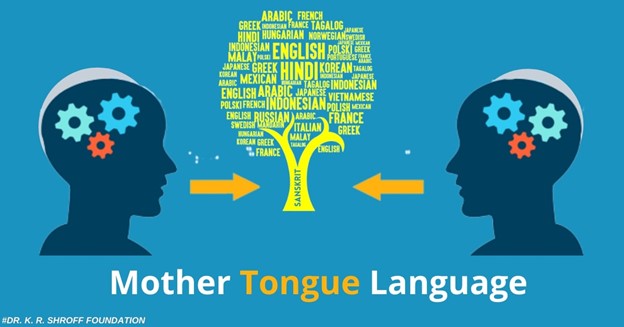LANGUAGE: THE ROLE OF MOTHER TONGUE IN FOREIGN LANGUAGE LEARNING
By: Yella Dezas Perdani

Source: https://www.krsf.in/blog/benefits-of-learning-in-mother-tongue-language/
The term “Mother” or “Mama” was typically the first word introduced to infants and toddlers. The word itself may be pretty straightforward, but its significance lies in the fact that it signifies the emotional bond between a mother and her kid. The symbols of a language are words. Language is the most fundamental means individuals think about one another in their social lives. It serves the purpose of being a channel of communication. The way in which individuals interact has been developing for over a thousand years. People used sounds comparable to grunts and hand gestures as their earliest modes of communication before the discovery of spoken language. Before the discovery of spoken language, people communicated using their voices. Today, people communicate through various languages, each reflecting some aspect of their identity or culture. One of the multiple languages spoken worldwide is a person’s mother tongue or the language spoken in their immediate area.
When children and their parents communicate using their mother tongue, this is intergenerational communication. It enhances their relationship and serves as a communication channel for day-to-day activities. “Mother language” refers to the colloquial language spoken by individuals in a person’s immediate environment. In addition to the national language, a person who has spent their entire life in West Java should be able to communicate in Sundanese or basa Sunda. However, if a person was born in Semarang, located in Central Java, Javanese is their first language. Diversity can be shown in the fact that different regions have their unique wording.
According to several experts, there are multiple purposes for utilizing the mother tongue when teaching English. First, when teachers use their mother tongue, students and teachers feel more at ease, especially when the pupils are at a lower level. It is constructive when students’ proficiency in the target language is restricted, particularly regarding grammatical principles.
Second, when a teacher teaches a linguistic concept in the student’s mother tongue, using the mother tongue in a foreign language classroom might help the students understand the material better. To help the students grasp grammar concepts and avoid mistakes when creating them, the teacher might instruct them in the many grammar principles found in both languages. Mother tongue can also be used to clarify grammar concepts. Some experts say teaching grammar ideas in one’s mother tongue is highly beneficial. Their results demonstrate the participants’ confidence when they comprehend the teacher’s provided stuff. Students familiar with the learning process will feel more comfortable sharing their opinions with the teacher rather than merely taking in new material. The teacher must use language that the pupils can understand to communicate effectively with them. Mother language can then provide feedback, reiterate critical elements, and clarify why the grammar idea is challenging.
Third, employing a foreign language effectively takes time, and the availability of time affects the employment of the mother tongue in classrooms teaching foreign languages. Teachers have to rush through content explanations with less time at their disposal. It indicates that, in terms of providing materials, speaking one’s home tongue is more efficient over time than speaking a foreign language. When speaking in their native tongue instead of English, kids can absorb and comprehend the subject more quickly. Mother tongue is sometimes utilized for clarification and comparison. To clearly distinguish between the two languages, the contrast between the grammar of the mother tongue and the foreign language is used here. The teacher clarifies this by providing instructions, framing the activities, and organizing them in the mother tongue. Therefore, the purpose of using the mother tongue is to encourage engagement and communication among the kids. The ability of low-level students to comprehend what the teacher says and to speak freely while engaging in the learning process is beneficial to them.
In short, using the mother tongue in a foreign language context has sparked a contentious discussion among education professionals and practitioners. Furthermore, it is imperative to solicit and uncover the opinions and perspectives of the teachers, who actively engage with and instruct the pupils in the classroom.
The research investigates their viewpoint regarding the utilization of the mother tongue in the foreign language classroom, its impact on student’s learning process, and the stage of teaching where the mother tongue is predominantly employed.
Source:
https://smktelkom-bdg.sch.id/two_important_different_languages/
https://mentarigroups.com/blog/en/indonesian-languages-regional-languages-and-foreign-languages/


Comments :